 Technology peripherals
Technology peripherals
 AI
AI
 Google and Stanford jointly issued an article: Why must we use large models?
Google and Stanford jointly issued an article: Why must we use large models?
Google and Stanford jointly issued an article: Why must we use large models?
Language models have profoundly changed the research and practice in the field of natural language processing. In recent years, large models have made important breakthroughs in many fields. They do not need to be fine-tuned on downstream tasks. With appropriate instructions or prompts, they can achieve excellent performance, sometimes even amazing.
For example, GPT-3 [1] can write love letters, scripts, and solve complex mathematical reasoning problems with data, and PaLM [2] can interpret jokes. The above example is just the tip of the iceberg of large model capabilities. Many applications have been developed using large model capabilities. You can see many related demos on the OpenAI website [3], but these capabilities are rarely reflected in small models.
In the paper introduced today, the capabilities that small models do not have but large models have are called emergent capabilities (Emergent Abilities), which means that the scale of the model is large enough to a certain extent. A sudden ability acquired later. This is a process in which quantitative changes produce qualitative changes.
The emergence of emergent capabilities is difficult to predict. Why the model suddenly acquires certain capabilities as the scale increases is still an open question that requires further research to answer. In this article, the author sorts out some recent progress in understanding large models and gives some related thoughts. I look forward to discussing it with you.
Related papers:
-
Emergent Abilities of Large Language Models.
http://arxiv. org/abs/2206.07682 -
Beyond the Imitation Game: Quantifying and extrapolating the capabilities of language models.
https://arxiv.org/abs/ 2206.04615
The emergent ability of large models
What is a large model? What size is considered "big"? This doesn't have a clear definition.
Generally speaking, model parameters may have to reach one billion levels before they show capabilities that are significantly different from the zero-shot and few-shot capabilities of small models. In recent years, there have been multiple models with hundreds of billions and trillions of parameters, which have achieved SOTA performance on a series of tasks. In some tasks, the model's performance improves reliably with increasing scale, while in other tasks, the model shows a sudden increase in performance at a certain scale. Two indicators can be used to classify different tasks [4]:
- Linearity: aims to measure the extent to which the model performs on the task as the scale increases have been reliably improved.
- Breakthroughness: Aims to measure how well a task can be learned when the model size exceeds a critical value.
These two indicators are functions of model size and model performance. For specific calculation details, please refer to [4]. The figure below shows some examples of high Linearity and high Breakthroughness tasks.
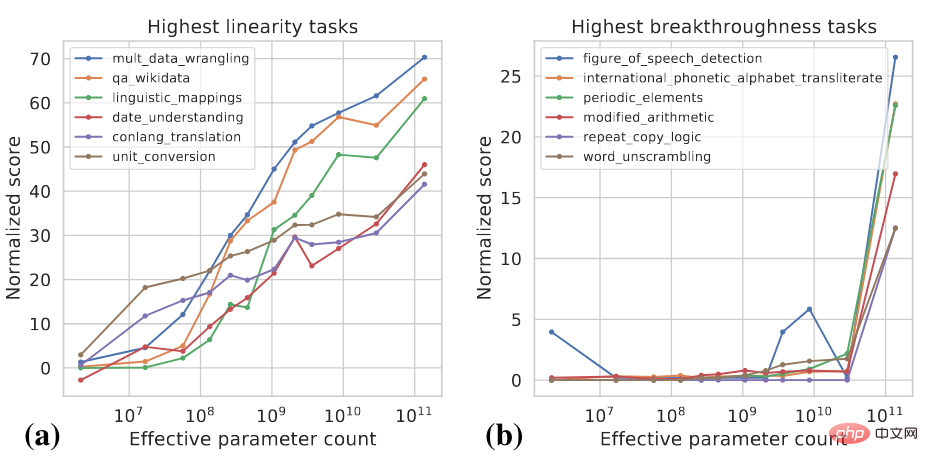
High linearity tasks are mostly knowledge-based, which means they mainly rely on memorizing the knowledge that exists in the training data. Information, such as answering factual questions. Larger models usually use more data for training and can remember more knowledge, so the model shows steady improvement in such tasks as the scale increases. High-breakthroughness tasks include more complex tasks that require the use of several different abilities or the execution of multiple steps to arrive at the correct answer, such as mathematical reasoning. Smaller models struggle to acquire all the capabilities needed to perform such tasks.
The following figure further shows the performance of different models on some high-breakthroughness tasks
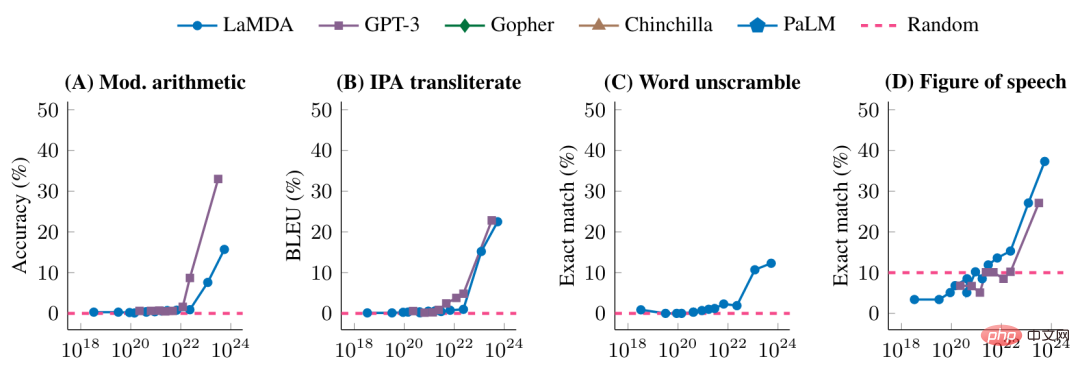
Before reaching a certain model scale, the model's performance on these tasks is random. After reaching a certain scale, there is a significant improvement.
Is it smooth or sudden?
What we saw earlier is that the model suddenly gained certain capabilities after the scale increased to a certain level. From the perspective of task-specific indicators, these capabilities are emergent, but from another perspective, the potential changes in model capabilities Smoother. This article discusses the following two perspectives: (1) using smoother indicators; (2) decomposing complex tasks into multiple subtasks.
The following figure (a) shows the change curve of the log probability of the real target for some high breakthroughness tasks. The log probability of the real target gradually increases as the model size increases.

Figure (b) shows that for a certain multiple-choice task, as the model size increases, The log probability of a correct answer increases gradually, while the log probability of an incorrect answer increases gradually up to a certain size and then levels off. After this scale, the gap between the probability of correct answers and the probability of wrong answers widens, and the model achieves significant performance improvements.
In addition, for a specific task, suppose we can use Exact Match and BLEU to evaluate the performance of the model. BLEU is a smoother indicator than Exact Match, and different indicators are used. There may be significant differences in the trends seen.
For some tasks, the model may gain partial ability to do this task at different scales. The picture below is the task of guessing the name of a movie through a string of emoji
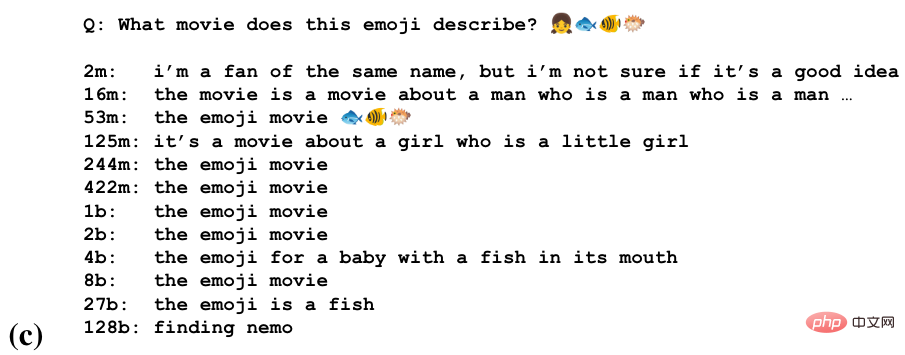
We can see that the model starts to guess at some scales Movie Titles, Recognizing the Semantics of Emojis at a Larger Scale, Producing Correct Answers at the Largest Scale.
Large models are sensitive to how tasks are formalized
The scale at which a model shows a sudden improvement in capabilities also depends on how the tasks are formalized. For example, on complex mathematical reasoning tasks, if standard prompting is used to treat it as a question and answer task, the performance improvement will be very limited as the model size is increased. However, if chain-of-thought prompting [5] is used as shown in the figure below, it will be treated as a question and answer task. Treated as a multi-step inference task, significant performance improvements will be seen at a certain scale.
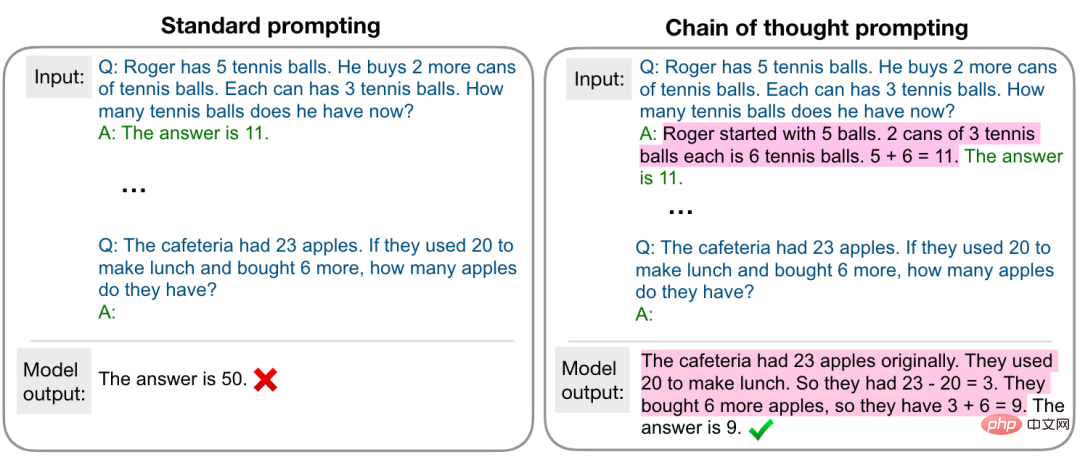
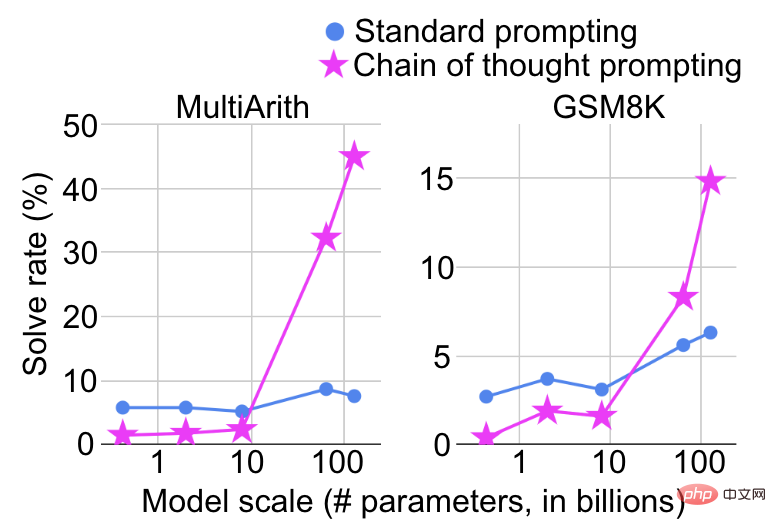

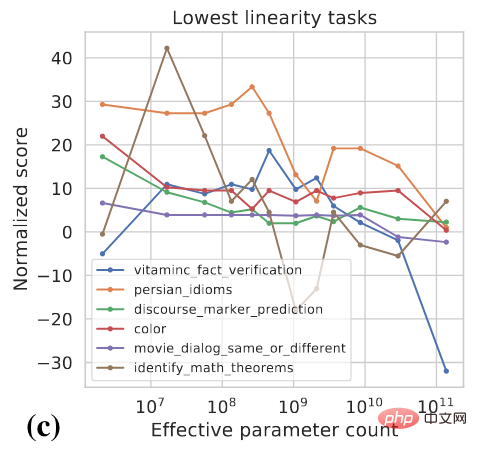
## Several researchers at New York University also organized a competition to find tasks where models perform worse as they get larger.
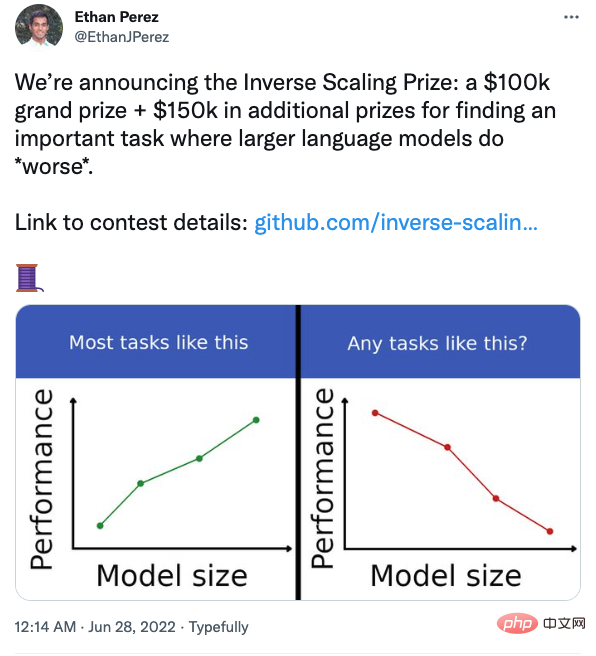
#For example, in a question and answer task, if you add your beliefs along with the question, the large model will be more easily affected. Interested students can pay attention.
Summary and Thoughts
- In most tasks, as the size of the model increases, the performance of the model becomes better. , but there will also be some counterexamples. More research is needed to better understand the behavior of models.
- #The ability of large models needs to be stimulated in appropriate ways.
- #Is the large model really doing inference? As we have seen before, by adding the prompt “Let’s think step by step”, the large model can perform multi-step reasoning and achieve satisfactory results on mathematical reasoning tasks. It seems that the model already possesses human reasoning capabilities. However, as shown below, if you give GPT-3 a meaningless question and let it do multi-step reasoning, GPT-3 seems to be doing reasoning, but in fact it is some meaningless output. As the saying goes "garbage in, garbage out". In comparison, humans can judge whether the question is reasonable, that is, whether the current question is answerable under given conditions. "Let's think step by step" can work. I think the fundamental reason is that GPT-3 has seen a lot of similar data during the training process. What it does is just predict the next token based on the previous token. Unlike humans, There are still fundamental differences in the way of thinking. Of course, if appropriate prompts are given to GPT-3 to determine whether the question is reasonable, it may be able to do so to some extent, but I am afraid there is still a considerable distance between "thinking" and "reasoning". This is not a simple matter. This can be solved by increasing the size of the model. Models may not need to think like humans, but more research is urgently needed to explore paths other than increasing model size.
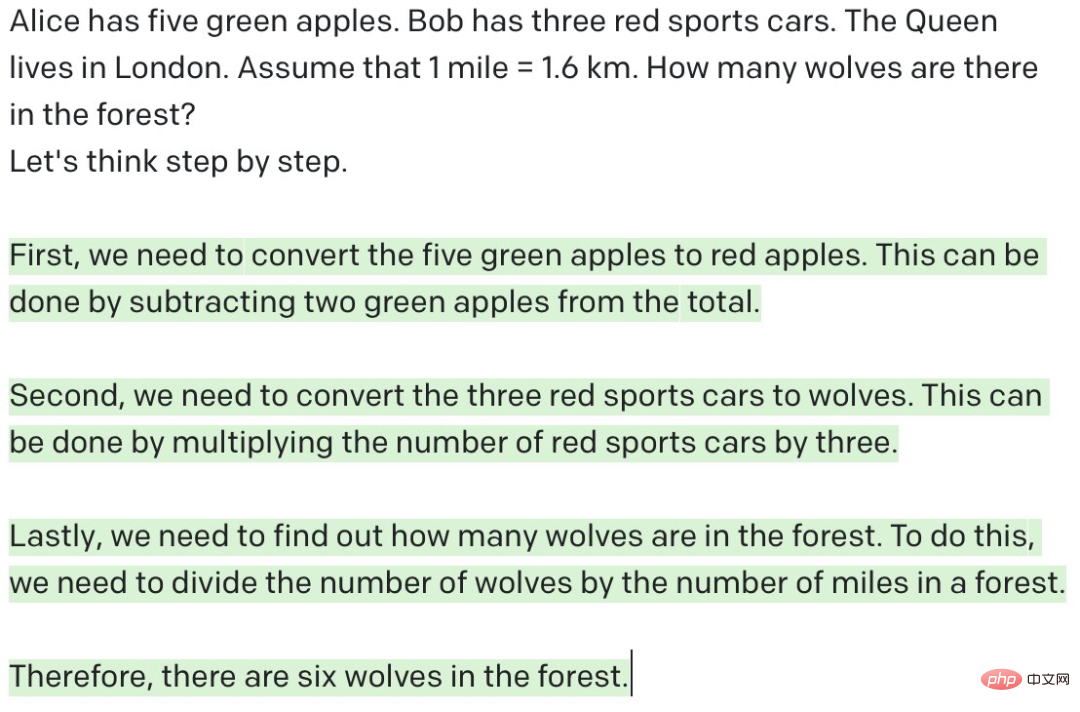
- System 1 or System 2? The human brain has two systems that cooperate with each other. System 1 (intuition) is fast and automatic, while System 2 (rationality) is slow and controllable. A large number of experiments have proven that people prefer to use intuition to make judgments and decisions, and rationality can correct the biases caused by it. Most current models are designed based on System 1 or System 2. Can future models be designed based on dual systems?
- #Query language in the era of large models. Previously, we stored knowledge and data in databases and knowledge graphs. We can use SQL to query relational databases, and SPARQL to query knowledge graphs. So what query language do we use to call the knowledge and capabilities of large models?
Mr. Mei Yiqi once said, "The so-called great scholar does not mean a building, but a master." The author uses an inappropriate term here. Let’s end this article with an analogy: the so-called large model does not mean that it has parameters, but that it has capabilities.
The above is the detailed content of Google and Stanford jointly issued an article: Why must we use large models?. For more information, please follow other related articles on the PHP Chinese website!

Hot AI Tools

Undresser.AI Undress
AI-powered app for creating realistic nude photos

AI Clothes Remover
Online AI tool for removing clothes from photos.

Undress AI Tool
Undress images for free

Clothoff.io
AI clothes remover

AI Hentai Generator
Generate AI Hentai for free.

Hot Article

Hot Tools

Notepad++7.3.1
Easy-to-use and free code editor

SublimeText3 Chinese version
Chinese version, very easy to use

Zend Studio 13.0.1
Powerful PHP integrated development environment

Dreamweaver CS6
Visual web development tools

SublimeText3 Mac version
God-level code editing software (SublimeText3)

Hot Topics
 1377
1377
 52
52
 phpmyadmin creates data table
Apr 10, 2025 pm 11:00 PM
phpmyadmin creates data table
Apr 10, 2025 pm 11:00 PM
To create a data table using phpMyAdmin, the following steps are essential: Connect to the database and click the New tab. Name the table and select the storage engine (InnoDB recommended). Add column details by clicking the Add Column button, including column name, data type, whether to allow null values, and other properties. Select one or more columns as primary keys. Click the Save button to create tables and columns.
 How to create an oracle database How to create an oracle database
Apr 11, 2025 pm 02:33 PM
How to create an oracle database How to create an oracle database
Apr 11, 2025 pm 02:33 PM
Creating an Oracle database is not easy, you need to understand the underlying mechanism. 1. You need to understand the concepts of database and Oracle DBMS; 2. Master the core concepts such as SID, CDB (container database), PDB (pluggable database); 3. Use SQL*Plus to create CDB, and then create PDB, you need to specify parameters such as size, number of data files, and paths; 4. Advanced applications need to adjust the character set, memory and other parameters, and perform performance tuning; 5. Pay attention to disk space, permissions and parameter settings, and continuously monitor and optimize database performance. Only by mastering it skillfully requires continuous practice can you truly understand the creation and management of Oracle databases.
 How to create oracle database How to create oracle database
Apr 11, 2025 pm 02:36 PM
How to create oracle database How to create oracle database
Apr 11, 2025 pm 02:36 PM
To create an Oracle database, the common method is to use the dbca graphical tool. The steps are as follows: 1. Use the dbca tool to set the dbName to specify the database name; 2. Set sysPassword and systemPassword to strong passwords; 3. Set characterSet and nationalCharacterSet to AL32UTF8; 4. Set memorySize and tablespaceSize to adjust according to actual needs; 5. Specify the logFile path. Advanced methods are created manually using SQL commands, but are more complex and prone to errors. Pay attention to password strength, character set selection, tablespace size and memory
 How to write oracle database statements
Apr 11, 2025 pm 02:42 PM
How to write oracle database statements
Apr 11, 2025 pm 02:42 PM
The core of Oracle SQL statements is SELECT, INSERT, UPDATE and DELETE, as well as the flexible application of various clauses. It is crucial to understand the execution mechanism behind the statement, such as index optimization. Advanced usages include subqueries, connection queries, analysis functions, and PL/SQL. Common errors include syntax errors, performance issues, and data consistency issues. Performance optimization best practices involve using appropriate indexes, avoiding SELECT *, optimizing WHERE clauses, and using bound variables. Mastering Oracle SQL requires practice, including code writing, debugging, thinking and understanding the underlying mechanisms.
 How to add, modify and delete MySQL data table field operation guide
Apr 11, 2025 pm 05:42 PM
How to add, modify and delete MySQL data table field operation guide
Apr 11, 2025 pm 05:42 PM
Field operation guide in MySQL: Add, modify, and delete fields. Add field: ALTER TABLE table_name ADD column_name data_type [NOT NULL] [DEFAULT default_value] [PRIMARY KEY] [AUTO_INCREMENT] Modify field: ALTER TABLE table_name MODIFY column_name data_type [NOT NULL] [DEFAULT default_value] [PRIMARY KEY]
 Detailed explanation of nested query instances in MySQL database
Apr 11, 2025 pm 05:48 PM
Detailed explanation of nested query instances in MySQL database
Apr 11, 2025 pm 05:48 PM
Nested queries are a way to include another query in one query. They are mainly used to retrieve data that meets complex conditions, associate multiple tables, and calculate summary values or statistical information. Examples include finding employees above average wages, finding orders for a specific category, and calculating the total order volume for each product. When writing nested queries, you need to follow: write subqueries, write their results to outer queries (referenced with alias or AS clauses), and optimize query performance (using indexes).
 What are the integrity constraints of oracle database tables?
Apr 11, 2025 pm 03:42 PM
What are the integrity constraints of oracle database tables?
Apr 11, 2025 pm 03:42 PM
The integrity constraints of Oracle databases can ensure data accuracy, including: NOT NULL: null values are prohibited; UNIQUE: guarantee uniqueness, allowing a single NULL value; PRIMARY KEY: primary key constraint, strengthen UNIQUE, and prohibit NULL values; FOREIGN KEY: maintain relationships between tables, foreign keys refer to primary table primary keys; CHECK: limit column values according to conditions.
 What does oracle do
Apr 11, 2025 pm 06:06 PM
What does oracle do
Apr 11, 2025 pm 06:06 PM
Oracle is the world's largest database management system (DBMS) software company. Its main products include the following functions: relational database management system (Oracle database) development tools (Oracle APEX, Oracle Visual Builder) middleware (Oracle WebLogic Server, Oracle SOA Suite) cloud service (Oracle Cloud Infrastructure) analysis and business intelligence (Oracle Analytics Cloud, Oracle Essbase) blockchain (Oracle Blockchain Pla



